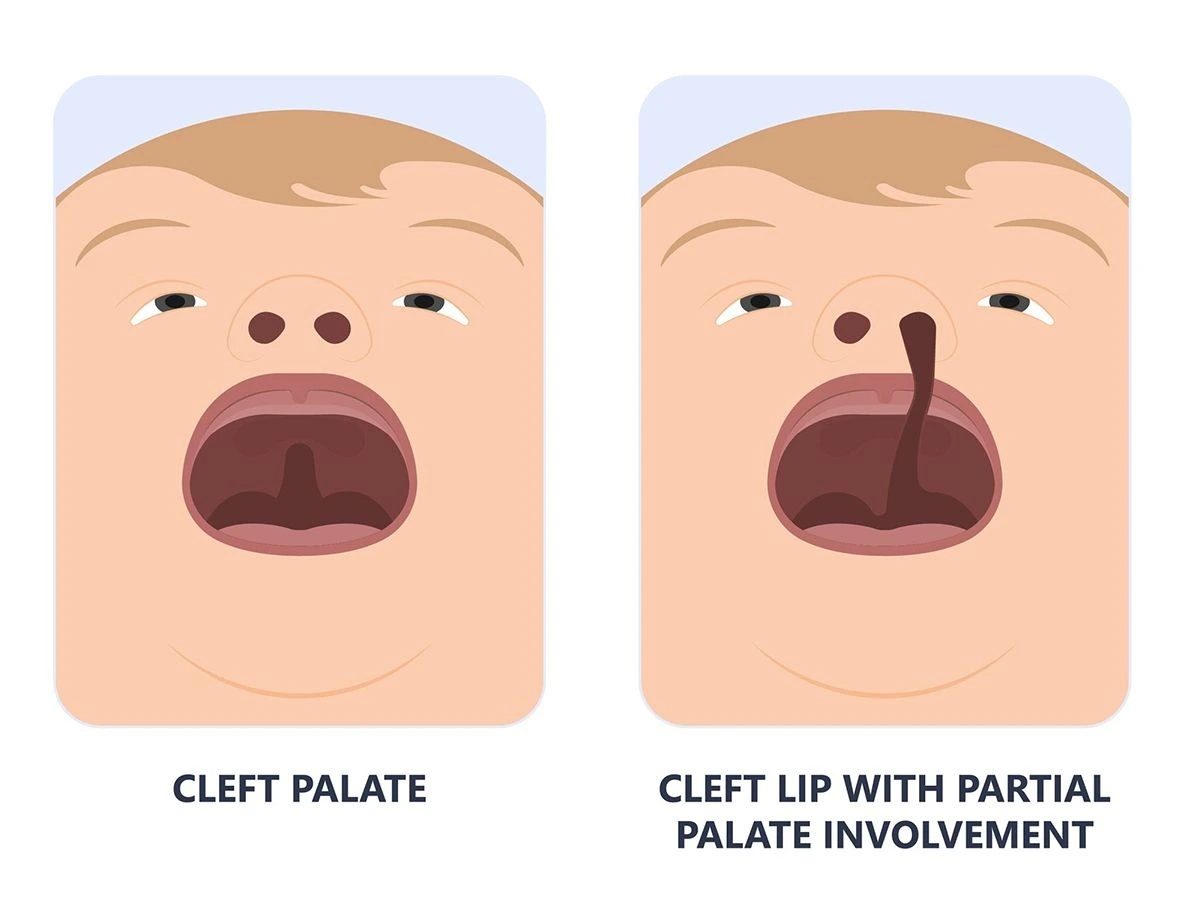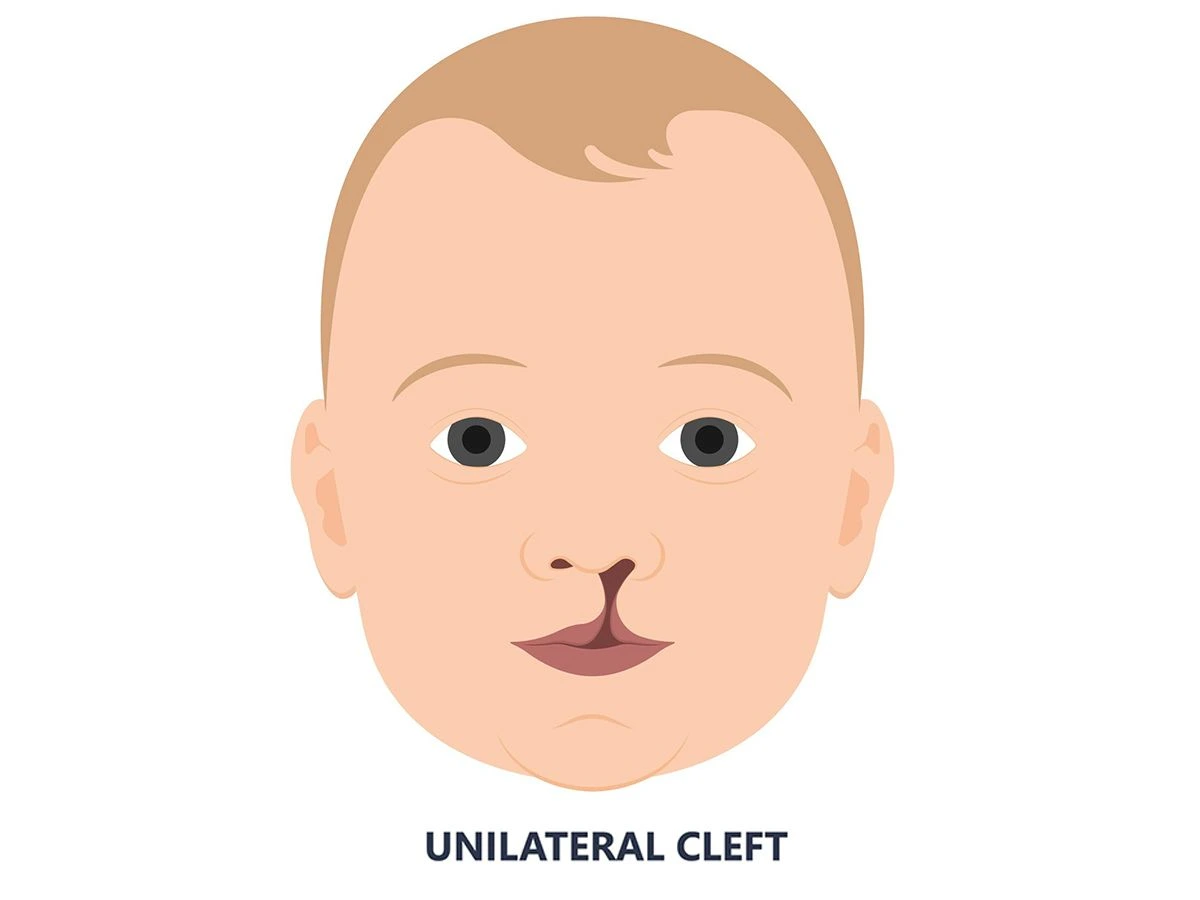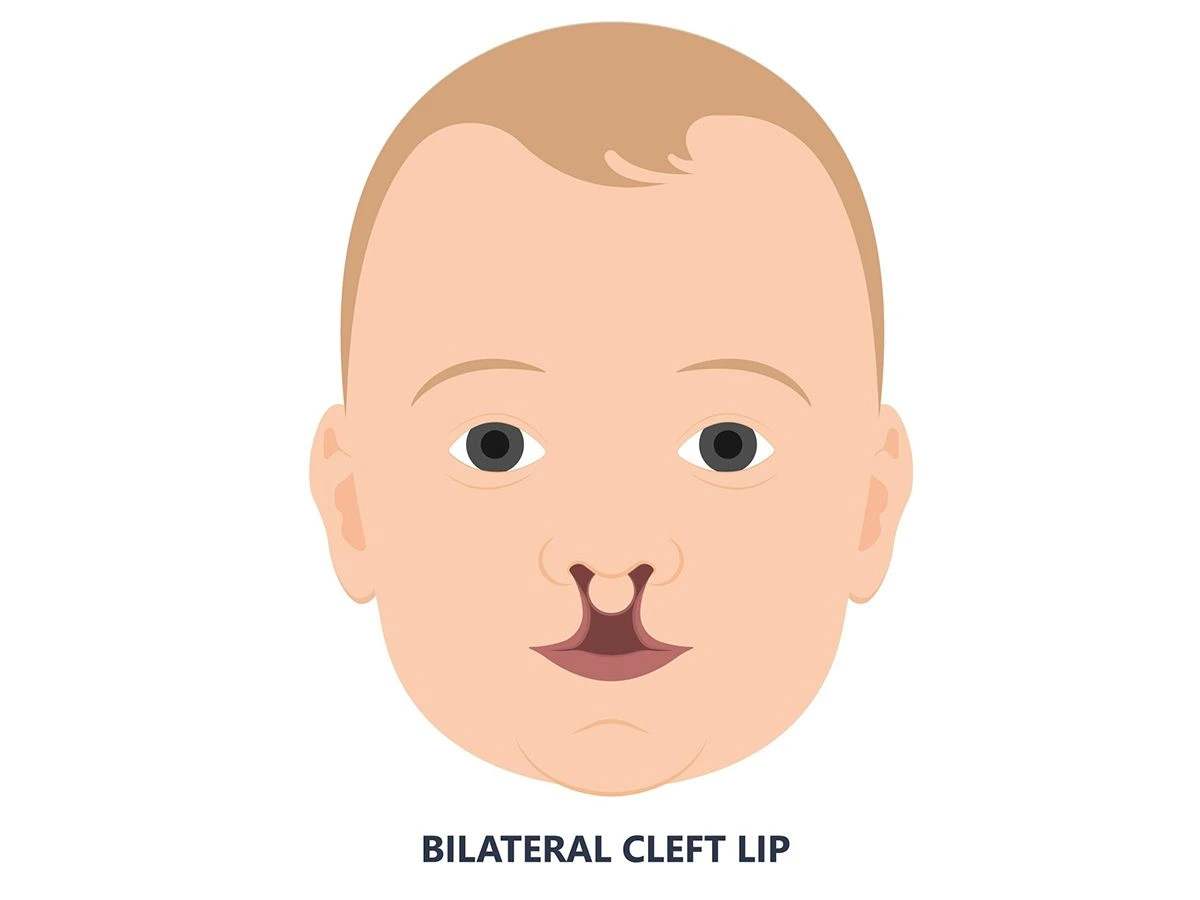Everything Parents Need To Know About Cleft Lip And Palate


A cleft lip or cleft palate is a developmental condition where the growth plates that form the roof of mouth and lips don’t come together and close properly. A cleft lip or palate occurs during gestation when the baby’s body is rapidly developing. Depending on the circumstances, a cleft can be unilateral (on one side) or bilateral (on both sides.)
What Is Cleft Lip And Palate?
A developmental cleft in your child’s mouth is when the skin and underlying tissues don’t fuse together properly during fetal development.

1) Cleft Lip
This common birth defect is when there is a slit in the lip, almost making it look like it is cut from the bottom of the top lip up to the nostril. There is no open skin, but the lip tissues don’t come all the way together to close up the top of the mouth. The bottom lip appears completely normal.
2) Cleft Palate
A cleft palate is when the roof of the mouth does not close up properly. There is essentially a large hole or crevice down the middle of the roof of the mouth, exposing the oral cavity to the sinuses above it.
3) Both Cleft Lip And Palate
In the case of a cleft lip and palate, there is a combination of clefts, forming a larger cleft through the lip and roof of mouth. The opening can extend all the way through the base of the nose to the back of the throat. There can be a unilateral or bilateral cleft lip with the cleft palate. This type of a cleft is quite significant; thankfully, surgical repair is extremely effective and will allow the child to have a normal life.
Cleft Lip Types
A child can have one of two types of a cleft lip: Unilateral or bilateral. Depending on the severity of each, a child’s cleft lip will impact their ability to nurse or take a bottle.
Unilateral Cleft Lip
A unilateral cleft lip is when one side of your child’s upper lip develops correctly, but the other side does not. The incorrectly developed side will only extend partially toward the midline, but will not fuse with the middle piece of tissue (philtrum) that extends down below the nose. The one-sided lip cleft will look like a slit cut into the lip all the way up into the nostril. It may involve just the lip itself or also the teeth and bone behind it.

Bilateral Cleft Lip
A bilateral cleft lip impacts both sides of your child’s mouth. It is essentially the same as a unilateral cleft, but there are two instead of one defect. Both sides of the upper lip fail to close with the philtrum below the nose. Like a one-sided cleft, bilateral lip clefts may only affect the lips, or the lips as well as the gums and teeth behind them.

What Causes Cleft Palate?
As your baby develops, there are different protrusions that come together at the midline of their face and fuse together to form the roof of the mouth, lips, and arch of teeth. If those tissues don’t come together all the way or fail to fuse, it leaves a slit-like opening or hole between them. We call this opening a cleft.
Unfortunately, there is no known cause of a cleft lip or palate. There are only risk factors and linked conditions that potentially increase the likelihood of a cleft (like mediation, smoking, being obese, having diabetes, or certain genetic disorders.)
Fortunately, orofacial clefts are one of the most common birth defects to occur in babies. As such, medical specialists have made great gains in how to treat and manage them.
One cause for cleft palate during gestational development is thought to be the size of the jaw and placement of the tongue, which can be due to a medical syndrome. The thought is that the baby’s tongue does not rest against the roof of the mouth properly, causing the growth plates in the roof of the mouth to fail to fuse.
How Is A Cleft Lip And Palate Diagnosed?
While a prenatal cleft diagnosis can be upsetting for parents, there is good news. Clefts can be treated predictably and effectively, allowing their child to enjoy a fairly normal childhood.
Complications With Cleft Lip And Palate?
Besides concerns over appearance, a cleft lip or palate will need to be treated because of developmental complications it will cause. Including:
Breast Feeding an Infant—Achieving a proper latch may be impossible for the baby to nurse and painful for the mother to even try. Special feeding equipment may be necessary.
Eating—An opening in your child’s palate or lips can make swallowing difficult or impossible. Risks can include food entering into the nasal sinus cavities, causing infection or potential aspiration into the lungs.
Growth and Development—When the tissues don’t close together around the mouth, it physically changes the way your child’s facial characteristics develop as they grow up.
Ear Infections And Hearing—Babies that have oral clefts may be at a higher risk of experiencing hearing challenges or frequent ear infections. They can also accumulate buildup inside of their ears, because of their oral anatomy.
Speech Development—The shape of your child’s mouth and lips impact their ability to form certain sounds. As they begin to learn how to talk, an untreated cleft lip and palate can result in significant speech delays.
Missing Teeth—Because tooth buds start developing early on during pregnancy, a cleft can interfere with tooth formation. Missing primary (baby) and permanent (adult) teeth are extremely common.
Cleft Palate Surgery
Cleft lip and palate conditions must be treated by a surgeon because of the significant impact they have in a child’s growth and development. Untreated conditions can cause delays, as well as significant loss of self-confidence. In developing countries, a cleft lip or palate may also impact the child’s socioeconomic factors, making it difficult for them or their family to maintain a normal quality of life.
Cleft lip repair is called a “cheiloplasty” and a cleft palate repair is called a “palatoplasty.” Both surgeries are performed under general anesthesia, where your infant is completely unaware of what is going on. This measure ensures your child’s comfort and safety so that the surgeon can carefully close the cleft and improve the symmetry of facial features (including both the lip and nose, if impacted.) Each different layer of tissue is closed and muscles may be rearranged to maximize oral function.
While cleft palate repairs are not visible from the outside, a cleft lip repair will usually leave a small scar just under the nose.
The surgeon performing the procedure may be a plastic surgeon and/or oral surgeon (dental specialist.)
At What Age Is Cleft Palate Repaired?
Depending on the severity of your child’s cleft, a palate repair is usually performed at somewhere between the age of 6-12 months. On the other hand, repairing a cleft lip is usually addressed earlier, at closer to 3-6 months. Typically, the severity of the cleft, how well your baby is able to feed, and whether it’s unilateral or bilateral will impact how quickly your pediatrician or oral surgeon wants to perform surgery. Medical experts recommend that cleft palates are always repaired before a child reaches 18 months of age.
Even though your baby is likely only a few months or just under a year old, the surgery is extremely safe. It’s extremely important to note that children with orofacial clefts often require follow-up surgeries as they grow and develop. Especially if there are missing teeth or the shape of their dental arch is affected. More isolated cleft lips may only require a single surgery to permanently correct them.
Can Cleft Lip Be Prevented?
Aside from eliminating any risk factors—such as medication and smoking—there may not be a lot that parents can do to help prevent their child from having a cleft lip. But getting screened for medical or genetic syndromes can help you better prepare for the chances of a cleft before your child is born. Avoiding environmental factors that could be potentially harmful to your child will promote an overall healthier pregnancy, not to mention reduce the chances of birth defects.
Supplementing with folic acid may possibly help reduce the chances of a cleft lip or palate. Folic acid is usually found in prenatal vitamins. If vitamins or supplements upset your stomach, be sure to take them with food or just before you go to sleep.
Why Do Babies Get A Cleft Lip?
Is A Cleft Palate Hereditary?
According to the Mayo Clinic, most cleft lip and palates are isolated birth defects, but they are also seen in certain types of genetic conditions or syndromes that are inherited from a person’s parents. Some common syndromes include Pierre Robin Sequence’ (PRS), Stickler Syndrome and 22q11 Deletion Syndrome. Doctors tend to suggest that children who are born with a cleft lip or palate receive genetic testing, as there may be some type of an undiagnosed syndrome that will need to be addressed. Since syndromes or genetic conditions can be passed from parent to child through their DNA, there could be a statistically higher risk for a child to have a cleft palate if their parent has a known or unknown medical syndrome or genetic disorder.
Is Cleft Lip More Common In Certain Countries?
According to the CDC, about 1 in 1,600 babies are born with a cleft lip and palate, 1 in 1,700 are born with a cleft palate, and 1 in 2,800 are born with a cleft lip without a cleft palate. But some countries have significantly higher rates, and they aren’t necessarily always developing countries. A study of over 55 countries found that the top three countries to have cleft lip and palate were Venezuela, Iran, and Japan. Each of them had a rate of 30 or higher cases per 10,000 births. Interestingly enough, the countries that were at a higher elevation had higher rates of cleft lip and palate than countries at lower elevations.
Talk To A Dentist
It’s never too early to speak to a dentist. If you are an expectant mother and your unborn baby shows a possible cleft on their sonogram or has already tested positive for a medical syndrome, it’s best to have a plan in place. But even if it’s after your baby is born, there will be medical experts to guide you through the process of the best steps to take. You will want to partner with a pediatric dentist and oral surgeon, who will oversee the reconstructive surgery and oral development of your child. Having a relationship with these providers before the birth of your child can be helpful. However, it’s not uncommon for parents to be unaware that their baby has a cleft lip or palate until the date of birth, so a surgeon can also be contacted immediately from the hospital where you deliver.
Bringing your child to a pediatric dentist for regular checkups from day one will help to promote proper oral development, bypass significant dental delays, and aid in feeding as your child grows.

Make your inbox smile!
Subscribe





